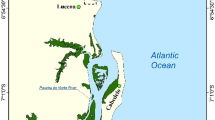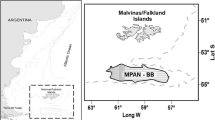Abstract
The objective of this study is to contribute to the knowledge gap on the biology of the longnose spurdog, Squalus blainville (Risso, 1827), that has very scarce information in the Levantine Sea, eastern Mediterranean Sea. This study utilized opportunistic sampling methods to fill information gaps without causing more damage or stress to a threatened species. Moreover, it provides information on longnose spurdog’s biological and ecological features from by-catch individuals. In this regard, a total of 184 individuals, 99 females and 85 males, at different maturity stages were examined. Among these individuals 66 (44 females, 32 males) had prey items in their stomach and the main food source was identified as teleosts (IRI % 63.55), and cephalopods (IRI % 22.38) and crustaceans (IRI % 12.78) were identified as a secondary food group. Trophic levels were estimated as 4.28, 4.13 and 4.05, for the datasets of all, female, and male, respectively. The information produced in this study is an important base line for regional assessment or for conservation measures for the species. Besides providing information on a data deficient species, this study also shows that the opportunistic method, utilizing landed by-catch individuals, produces information for scientific purposes and can be practical and effective to assess regional status as well as develop species-specific measures in regional scale.




Similar content being viewed by others
Data Availability
The datasets generated during and/or analyzed during the current study are not publicly available but are available from the corresponding author on reasonable request.
References
Anastasopoulou A, Mytilineou C, Makantasi P et al (2018) Life history aspects of two species of the Squalus genus in the Eastern Ionian Sea. J Mar Biol Assoc United Kingdom 98:937–948. doi: https://doi.org/10.1017/S0025315416001818
Bengil EGT, Başusta N (2018) Chondrichthyan species as by-catch: A review on species inhabiting Turkish waters. J Black Sea / Mediterr Environ 24:288–305
Bengil F, Bengil EGT, Mavruk S et al (2019) Feeding Ecology of Four Demersal Shark Species (Etmopterus spinax, Galeus melastomus, Scyliorhinus canicula and Squalus blainville) from the Eastern Aegean Sea. Turkish J Fish Aquat Sci 19:475–484. doi: https://doi.org/10.4194/1303-2712-v19_6_03
Bok DT, Gokturk D, Kahraman AE et al (2011) Length-weight relationships of 34 fish species from the Sea of Marmara, Turkey. J Anim Vet Adv 10:3037–3042
Bonnici L, Bonello JJ, Schembri PJ (2018) Diet and trophic level of the longnose spurdog, Squalus blainville (Risso, 1826) in the 25-nautical mile Fisheries Management Zone around the Maltese Islands. Reg Stud Mar Sci 19:33–42. doi: https://doi.org/10.1016/j.rsma.2018.03.001
Braccini JM, Hamlett WC, Gillanders BM, Walker TI (2006) Embryo development and maternal–embryo nutritional relationships of piked spurdog (Squalus megalops). Mar Biol 150:727–737. doi: https://doi.org/10.1007/s00227-006-0393-2
Bradaï MN, Saïdı B, Ghorbel M, Bouaïn A, Guelorget O (2002) Observations sur les requins du golfe de Gabès (Tunisie méridionale, Méditerranée centrale). Mésogée (Marseille) 60:61–77
Cannizzaro L, Rizzo P, Levi D, Gancitano S (1995) Age determination and growth of Squalus blainvillei. Fish Res 23 1826:113–125Risso
Carpenter KE, Niem VH (1998) Volume 2. Cephalopods, crustaceans, holothurians and sharks. Food And Agriculture Organization Of The United Nations, Rome
Cavanagh RD, Gibson C (2007) Overview of the Conservation Status of Cartilaginous Fishes (Chondrichthyans) in the Mediterranean Sea. Gland, Switzerland and Malaga, Spain
Coker T, Akyol O (2014) An overview on the fish diversity in coasts of Turkish Republic of Northern Cyprus (Mediterranean). Ege J Fish Aquat Sci 31:113–118. doi: https://doi.org/10.12714/egejfas.2014.31.2.08
Compagno LJV (1984) FAO species catalogue. Vol. 4. Sharks of the world. An annotated and illustrated catalogue of sharks species known to date. Part 1. Hexanchiformes to Lamniformes. FAO, Rome
Cortes E (1999) Standardized diet compositions and trophic levels of sharks. ICES J Mar Sci 56:707–717. doi: https://doi.org/10.1006/jmsc.1999.0489
Damalas D, Vassilopoulo V (2011) Chondrichthyan by- catch and discards in the demersal trawl fishery of the central Aegean Sea (Eastern Mediterranean). Fish Res 108:142–152
Dulvy NK, Allen DJ, Ralph GM, Walls RHL (2016) The Conservation Status Of Sharks, Rays And Chimaeras In The Mediterranean Sea. Malaga, Spain
Dulvy NK, Fowler SL, Musick JA et al (2014) Extinction risk and conservation of the world’s sharks and rays. Elife 3:e00590. doi: https://doi.org/10.7554/eLife.00590
Ebert DA, Dando M (2020) Stingrays And Related Species Myliobatiformes. Field Guide to Sharks, Rays & Chimaeras of Europe and the Mediterranean. Princeton University Press, pp 139–185. https://doi.org/10.1515/9780691211824-010
Ebert DA, Dando M, Fowler S (2021) Introduction. Sharks Of The World: A Complete Guide. Princeton University Press, pp 11–17. https://doi.org/10.1515/9780691210872-004
Eronat EGT, Özaydın O (2014) Length-weight relationship of cartilaginous fish species from Central Aegean Sea (Izmir Bay and Sığacık Bay). Ege J Fish Aquat Sci 31:119–125. doi: https://doi.org/10.12714/egejfas.2014.31.3.01
FAO (2000) Fisheries management. 1. Conservation and management of sharks. FAO Technical Guidelines for Responsible Fisheries. Technical Report 4. Rome
Fricke R, Eschmeyer WN, Fong JD(2022) Eschmeyer’s Catalog of Fishes. Species by family/subfamily
Froese R, Pauly D(2019) FishBase. In: www.fishbase.org, version (12/2019
Giovos I, Chatzispyrou A, Doumpas N et al (2018) Using unconventional sources of information for identifying critical areas for the endangered guitarfish in Greece. J Black Sea/Mediterranean Environ 24:38–50
Güven O, Kebapçıoğlu T, Deval MC (2012) Length-weight relationships of sharks in Antalya Bay, eastern Mediterranean. J Appl Ichthyol 28:278–279. doi: https://doi.org/10.1111/j.1439-0426.2011.01823.x
Heath MR, Neat FC, Pinnegar JK et al (2012) Review of climate change impacts on marine fish and shellfish around the UK and Ireland. Aquat Conserv Mar Freshw Ecosyst 22:337–367. doi: https://doi.org/10.1002/aqc.2244
Hobday AJ, Griffiths S, Ward T (2009) Pelagic Fishes and Sharks. In: Poloczanska ES, Hobday AJ, Richardson AJ (eds) A Marine Climate Change Impacts and Adaptation. NCCARF, Australia, pp 1–23
Hyslop EJ (1980) Stomach contents analysis-a review of methods and their application. J Fish Biol 17:411–429. doi: https://doi.org/10.1111/j.1095-8649.1980.tb02775.x
ICES (2013) Report of the workshop on Sexual Maturity Staging of Elasmobranchs (WKMSEL). Lisbon
Ismen A, Cigdem Yigin C, Altinagac U, Ayaz A (2009) Length-weight relationships for ten shark species from Saros Bay (North Aegean Sea). J Appl Ichthyol 25:109–112. doi: https://doi.org/10.1111/j.1439-0426.2009.01263.x
İşmen A, Ozen O, Altinagac U et al (2007) Weight–length relationships of 63 fish species in Saros Bay, Turkey. J Appl Ichthyol 23:707–708. doi: https://doi.org/10.1111/j.1439-0426.2007.00872.x
Kabasakal H (2002) Stomach contents of the longnose spurdog Squalus blainvillei (Risso, 1826) from the North-Eastern Aegean Sea. Ann Ser Hist Nat 12:161–166
Kabasakal H(2020) A Field Guide to the Sharks of Turkish Waters. Turkish Marine Research Foundation (TUDAV) Publication No: 55, Istanbul, Turkey. 133 p
Kousteni V, Kasapidis P, Kotoulas G, Megalofonou P (2016) Evidence of high genetic connectivity for the longnose spurdog Squalus blainville in the Mediterranean Sea. Mediterr Mar Sci 17:371–383. doi: https://doi.org/10.12681/mms.1222
Kousteni V, Megalofonou P (2011) Reproductive biology and embryonic development of Squalus blainvillei in the eastern Mediterranean Sea. Sci Mar 75:237–349. doi: https://doi.org/10.3989/scimar.2011.75n2237
Kousteni V, Megalofonou P (2015) Aging and life history traits of the longnose spiny dogfish in the Mediterranean Sea: New insights into conservation and management needs. Fish Res 168:6–19
Lteif M, Mouawad R, Jemaa S et al (2016) The length-weight relationships of three sharks and five batoids in the Lebanese marine waters, eastern Mediterranean. Egypt J Aquat Res 42:475–477
Marouani S, Kadri H, Saidi B et al (2012) Age, growth, longevity, natural mortality and maturity of the longnose spurdog, Squalus blainvillei (Chondrichthyes: Squalidae), in the Gulf of Gabès (Central Mediterranean Sea). Cah Biol Mar 53:197–204
Martinho F, Sá C, Falcão J et al (2012) Comparative feeding ecology of two elasmobranch species, Squalus blainville and Scyliorhinus canicula, off the coast of Portugal. Fish Bull 110:71–84
Merella P, Quetglas A, Alemany F, Carbonell A (1997) Length-weight relationship of fishes and cephalopods from tile Balearic Islands (western Mediterranean). ICLARM Q 20:66–68
Newell BM, Cantillo AY, Pikula L, Hale KK, Collins EV, Caballero R(2017) Status Review Report of Two Species of Guitarfish: Rhinobatos rhinobatos and Rhinobatos cemiculus. USA
Öztekin A, Özekinci U, Daban IB (2016) Length-weight relationships of 26 fish species caught by longline from the Gallipoli peninsula, Turkey (northern Aegean Sea). Cah Biol Mar 57:335–342
Pallaoro A, Jardas I, Santic M (2005) Weight-length relationships for 11 chondrichthyan species in the eastern Adriatic Sea. Cybium2 29:93–96
Pauly D, Froese R, Sala PS, Palomares ML, Christensen V, Rius J (2000) Trophlab manual. in: ICLARM. Manila, Philippines
Rochowski BEA, Graham KJ, Day RW, Walker TI (2015) Reproductive biology of the greeneye spurdog Squalus chloroculus (Squaliformes, Squalidae). J Fish Biol 86:734–754. doi: https://doi.org/10.1111/jfb.12593
Sakalli A, Yucel N, Capapé C (2016) Confirmed occurrence in the Mediterranean Sea of Mobular japanica (Müller and Henle, 1841) with a first record off the Turkish coasts. J J Appl Ichthyol 32:1232–1234
Serena F (2005) Field identification guide to the sharks and rays of the Mediterranean and Black Sea, Species Id. FAO, Livorno
Serena F, Papaconstantinou C, Relini G et al (2009) 12. Distribution and Abundance of Spiny Dogfish in the Mediterranean Sea Based on the Mediterranean International Trawl Survey Program. In: Galluci VF, McFarlane GA, Bargmann GG (eds) Biology and Management of Dogfish Shark. American Fisheries Society, Washington, USA, pp 139–149
Shester GG, Micheli F (2011) Conservation challenges for small-scale fisheries: Bycatch and habitat impacts of traps and gillnets. Biol Conserv 144:1673–1681. doi: https://doi.org/10.1016/j.biocon.2011.02.023
Snene H, Range L, Quilichini Y et al (2021) First description of Chloromyxum squali Gleeson and Adlard, 2012 (Myxozoa) in the Mediterranean Sea in a new host Squalus blainville (Chondrichthyes: Squalidae): morphological, ultrastructural and phylogenetic data. Parasitol Res 120. https://doi.org/10.1007/s00436-021-07202-y
Soldo A, Bradai MN, Buscher E et al (2016) Squalus blainville. The IUCN Red List of Threatened Species 2016: e.T161536A89230091. In: IUCN Red List
Stehmann M, Thiel R, Rosenthal H (2009) Research on Elasmobranchs (sharks, skates and rays) – improving our knowledge base to conserve and manage these highly endangered and ancient fish. J Appl Ichthyol 25:1–2. doi: https://doi.org/10.1111/j.1439-0426.2009.01307.x
Stevens JD, Wiley PD (1986) Biology of two commercially important carcharhinid sharks from northern Australia. Mar Freshw Res 37:671–688
Torcu H, Aka Z, Işbilir A (2001) An Investigation on Fishes of The Turkish Rebuplic of Northern Cyprus. Turkish J Vet Anim Sci 25:155–159
Weber M, Fordham S (1997) Managin Shark Fisheries. Opportunities for International Conservation
Whitehead PJ, Bauchot MLL, Hureau JCC et al (1986) Fishes of the North-eastern Atlantic and the Mediterranean. UNESCO publication, Paris
Yücel N, Sakalli A, Karahan A (2017) First record of the honeycomb stingray Himantura leoparda (Manjaji-Matsumoto and Last, 2008) (Myliobatoidei: Dasyatidae) in the Mediterranean Sea, confirmed by DNA barcoding. J Appl Ichthyol 33:530–532
Acknowledgements
Author would like to thank Dr. Fethi BENGIL, SPOT-Society for the Protection of Turtles and the fishermen of Northern Cyprus for their help throughout this study. I would like to thank also Helen Sue ERONAT for English proofreading. The use of marine animals was approved by permitting authority of North Cyprus with permit reference number HYD.0.00-251.06-18-E.467.
Funding
This research did not receive any specific grant from funding agencies in the public, commercial, or not-for-profit sectors.
Author information
Authors and Affiliations
Corresponding author
Ethics declarations
Conflict of Interest
The authors declare that they have no conflict of interest.
Ethical Approval
All applicable international, national, and/or institutional guidelines for the care and use of animals were followed by the authors.
Sampling and Field Studies
All necessary permits for sampling and observational field studies have been obtained by the author from the competent authorities and are mentioned in the acknowledgements.
Additional information
Publisher’s Note
Springer Nature remains neutral with regard to jurisdictional claims in published maps and institutional affiliations.
Rights and permissions
Springer Nature or its licensor holds exclusive rights to this article under a publishing agreement with the author(s) or other rightsholder(s); author self-archiving of the accepted manuscript version of this article is solely governed by the terms of such publishing agreement and applicable law.
About this article
Cite this article
Bengil, E.G.T. Biology and Ecology of Squalus Blainville (Risso, 1827) from the Eastern Mediterranean. Thalassas 38, 1423–1432 (2022). https://doi.org/10.1007/s41208-022-00482-w
Received:
Revised:
Accepted:
Published:
Issue Date:
DOI: https://doi.org/10.1007/s41208-022-00482-w




